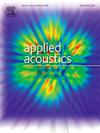Sound Transmission Performance of Plate-Type Acoustic Metamaterials for Quieter Aircraft Cabins
IF 3.4
2区 物理与天体物理
Q1 ACOUSTICS
引用次数: 0
Abstract
Acoustic Metamaterials (AMMs) are man-made materials that consist of a regular pattern of sub-wavelength microstructures, referred to as ‘unit cells’ and are intended to control sound waves in a way that is distinct from that of traditional acoustic materials. The current research work primarily focuses on using plate-type acoustic metamaterials to attenuate the aircraft cabin noise, in order to provide a comfortable (quieter) atmosphere within the aircraft cabin for the passengers during their flight. Estimation of Sound Pressure Levels (SPL) are carried out in two stages; the first stage is performed at the coupon level, where the best design is chosen out of eight unit cell designs for the experiments, based on the structural design optimization at the coupon level; followed by finite element based vibroacoustic analysis is performed on the fuselage structure using the selected unit cell. The performances of the developed acoustic metamaterials in terms of Sound Transmission Loss (STL) are investigated experimentally using an impedance tube, and the use of 3D printed casing inside the impedance tube for holding the AMM specimen with airgap, is first of its kind. The study shows, for a constant thickness (t = 0.5 mm) of designed AMM, at various frequencies, the reductions of SPL is observed in the range of 15.3 dBA to 73.9 dBA. Considering the numerical analysis and experimental studies finding, it is observed that the implementation of this developed acoustic metamaterials into a aircraft fuselage construction has effectively reduced noise levels in the aircraft cabin.

板式声学超材料在飞机机舱静音中的传声性能
声学超材料(AMMs)是一种人造材料,由亚波长微结构的规则模式组成,称为“单位细胞”,旨在以与传统声学材料不同的方式控制声波。目前的研究工作主要集中在利用板式声学超材料来衰减飞机客舱噪声,为乘客在飞行过程中提供舒适(更安静)的客舱环境。声压级的估算分两个阶段进行;第一阶段在单元水平上进行,根据单元水平的结构设计优化,从8个单元设计中选择最佳设计进行实验;然后采用选定的单元格对机身结构进行了基于有限元的振动声分析。利用阻抗管实验研究了所研制的声学超材料的声传输损耗(STL)性能,并首次在阻抗管内使用3D打印的套管来容纳带气隙的AMM试样。研究表明,当设计的AMM厚度恒定(t = 0.5 mm)时,在不同频率下,声压级的降低范围为15.3 ~ 73.9 dBA。结合数值分析和实验研究发现,将这种声学超材料应用到飞机机身结构中,可以有效地降低飞机机舱内的噪声水平。
本文章由计算机程序翻译,如有差异,请以英文原文为准。
求助全文
约1分钟内获得全文
求助全文
来源期刊

Applied Acoustics
物理-声学
CiteScore
7.40
自引率
11.80%
发文量
618
审稿时长
7.5 months
期刊介绍:
Since its launch in 1968, Applied Acoustics has been publishing high quality research papers providing state-of-the-art coverage of research findings for engineers and scientists involved in applications of acoustics in the widest sense.
Applied Acoustics looks not only at recent developments in the understanding of acoustics but also at ways of exploiting that understanding. The Journal aims to encourage the exchange of practical experience through publication and in so doing creates a fund of technological information that can be used for solving related problems. The presentation of information in graphical or tabular form is especially encouraged. If a report of a mathematical development is a necessary part of a paper it is important to ensure that it is there only as an integral part of a practical solution to a problem and is supported by data. Applied Acoustics encourages the exchange of practical experience in the following ways: • Complete Papers • Short Technical Notes • Review Articles; and thereby provides a wealth of technological information that can be used to solve related problems.
Manuscripts that address all fields of applications of acoustics ranging from medicine and NDT to the environment and buildings are welcome.
 求助内容:
求助内容: 应助结果提醒方式:
应助结果提醒方式:


